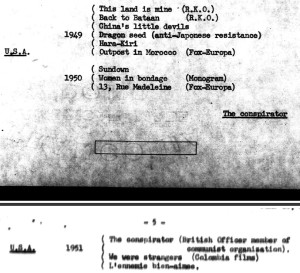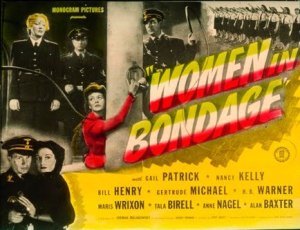I found a list of American movies that were banned in French Indochina in 1949-1951. It’s interesting to see the kinds of things that the colonial censors did not want movie viewers to see.
When I first looked at the list and saw titles like Women in Bondage, Dragon Seed, China’s Little Devils and 13 Rue Madeleine I started to wonder if Hollywood had perhaps made some risqué movies at that time that I was unaware of, but that is not the case.
Instead, the “women in bondage” in the film of that name (1943) were women in Germany living under the “social bondage” of Nazi control, one of whom resists and becomes a martyr for the cause of freedom.
“China’s little devils” (1945), meanwhile, were children who fought against the Japanese in World War II.
Dragon Seed (1944) also deals with anti-Japanese resistance. Based on Pearl Buck novel of the same name, this film stars Audrey Hepburn as “Jade,” a Chinese peasant woman who, in contrast to the men in her village, stands up against the Japanese. There is a fascinating trailer for this film here.
Another American film that was banned was This Land is Mine. This 1943 movie was about people resisting the Nazis in a European country.
In France the movie was released as Vivre Libre (Live Free). . .
Speaking of France, “13 Rue Madeleine” was the location of a Gestapo (Nazi secret police) headquarters in German-occupied France. The plot of this movie (1947) is too complex to relate here, but essentially it involves an American OSS officer who goes to France and outsmarts his German counterpart.
That an American OSS officer had to save the day in France does not, of course, present the French in the best light. More sympathetic was the 1949 Outpost in Morocco, about members of the French Foreign Legion who successfully put down an uprising by indigenous tribesmen. . .
And then finally there was the 1941 film, Sundown, about British resistance against the Germans in Africa, during which they came across a white woman who had “gone native.”
What should be clear by now is that the main “unacceptable” aspect of these films was their depiction of oppressed peoples fighting for their freedom (or in the case of Outpost in Morocco, the depiction of the French as suppressors). And in World War II, those oppressed peoples were Europeans and Americans.
Scholars have said many times over that the colonial educational system created a contradiction. Once, for instance, the French started to teach the Vietnamese about “nos ancêtres les Gaulois” and the French Revolution, so the story goes, the seed for anti-French revolution was planted.
That may be true to some extent, but by the 1930s there was no sign that revolution had any chance of success until World War II came along. World War II did this by transforming the political landscape, but also because it presented a new “liberation discourse,” which in turn created a new contradiction.
Europeans, Chinese and Americans fought for liberation in World War II. . . so why shouldn’t Indochinese do the same after the war?
That liberation discourse existed in American films, and that is why the colonial censors in Indochina banned them.
This then brings up an interesting question – who exactly were the “colonial censors”? Was this a group of Frenchmen? I not clear about this, but from the above passage, it looks like Vietnamese officials in the post-war Indochinese government had a say in these matters.










